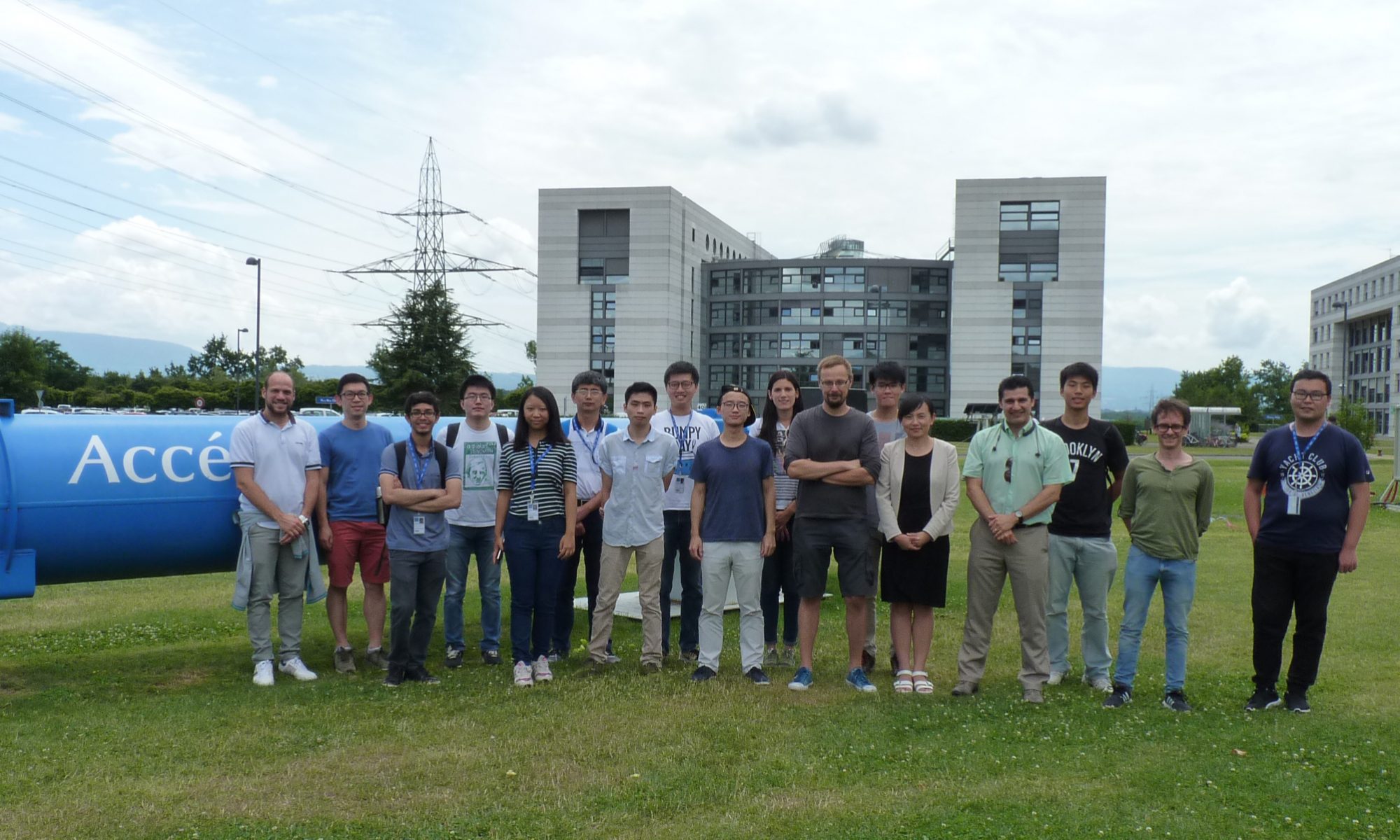Content
Supersymmetry, also known as SUSY, is an extension of the Standard Model which has no direct evidence yet, but has drawn the attention of many physicists because it could beautifully solve some of the crisis (example?) in cosmology and particle physics. Evidence of SUSY has been actively searched for, and we are participating in it through searching for SUSY electroweak production of SUSY particles in 2 and 3 lepton final states. The results so far do not signify the existence of SUSY. Our studies put limits on the masses of the SUSY particles that are predicted by SUSY.
The section below is a brief introduction to SUSY. For those readers who are already familiar with it, please jump to next section about our research on SUSY electroweak production.
Introduction to SUSY
Motivations
The Standard Model of particles is quite successful, yet it is incomplete. The Higgs boson explains where the mass of particles comes from. It was predicted that the Higgs boson should be heavy due to its interaction with other particles, but it turns out to be quite light. This gives rise to the “hierarchy problem”, which states that the lightness of the Higgs could be explained by the Standard Model only if there is dedicate fine-tuning in theory, which is quite weird.
SUSY is to the rescue.
Predictions of SUSY — superpartners
SUSY predicts that every particle has a superpartner (also known as SUSY partner, or simply partner particle) — a certain type of boson has a superpartner which is a fermion, and they have the same internal quantum numbers (beside spin). For example, the electron would have a superpartner called “selectron”. SUSY explains the lightness of the Higgs boson by introducing the interaction of the superpartner with the Higgs boson. Each particle in the pair of superpartners interacts with the Higgs boson, and their effects cancel out. Thus, less fine-tuning in theory is required, if SUSY is proven to exist.
| SUSY Particle Type | Characteristics |
|---|---|
| chargino χ˜± | electrically charged fermion |
| neutralino χ˜0 | electrically neutral fermion |
| slepton l˜ | superpartner of lepton |
| sneutrino ν˜ | superpartner of neutralino |
In addition to the hierarchy problem, SUSY explains some other mysteries:
- Dark Matter
- Unification strong, weak, and electromagnetic forces
- A candidate for superstring theory
However, all known particles today do not form any pairs of superpartners. Physicists are searching for such pairs and we are one of them.
SUSY Models
Some supersymmetric theoretical models have been proposed under different sets of assumptions. 2 of the models are considered in this study:
- pMSSM (Phenomenological Minimal Supersymmetric Standard Model): pMSSM makes several assumptions to simplify analysis. It only allows the direct production of charginos and neutralinos via W/Z bosons and their decay via right-handed sleptons, gauge bosons and Higgs bosons.
- Simplified Models: Simplified Models strip most of the complexity of SUSY to give a coarse level description of SUSY-like physics. The masses and decay modes of the relevant particles are the only free parameters.
Method of the Research
2 independent but similar methods are applied to search for SUSY particles. SUSY particles are difficult to be detected directly, but we can deduce their existance indirectly through other by-products particles in a decay. The trick is old but effective: the SUSY particles carry some momentum away, so there will be “missing transverse momentum” in other particles. We are aiming at detecting such events.
In the 8 TeV run of LHC in 2012, 2 beams of high-energy protons were collided. According to Simplified Models, such an event could produce SUSY particles, leading to “missing transverse momentum”. It is predicted that the final states of SUSY particle decay production would have 2-leptons and 3-leptons final states in different scenarios, as illustrated in Fig.1 and Fig.2 (HOW TO READ THE GRAPH).
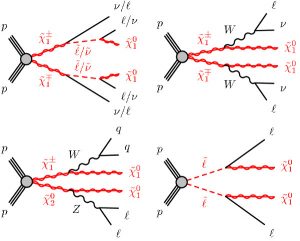
Fig.1: 4 different scenarios for the decay of χ˜20 and χ˜1±, with 2 leptons in the final states. Note that the bottom right process is mediated by slepton l˜.
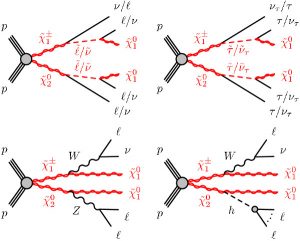
Fig.2: 4 different scenarios for the decay of χ˜20 and χ˜1±, with 2 leptons in the final states. The top left process is mediated by slepton l˜, and the top right process is mediated by τ˜.
Anticipating the above processes, we studied LHC p-p collision data, and selected events with a 2-leptons trigger in one research, and with a 3-lepton trigger in another research. The trigger selected events in which 2 (or 3) leptons candidates with transverse momenta exceeding a set of threshold, which signified “missing transverse momentum”, and the presence of SUSY particles that we are searching for.
Results were also interpreted in dedicated pMSSM scenarios.
Background Signal from Standard Model
Merely detecting “missing transverse momentum” does not necessarily indicate events associated with SUSY particles. The Standard Model background has to be considered, which can also lead to events with 2 (or 3) leptons being detected.
The background signal was taken care by simulating those events according to the Standard Model. If the experimental signal deviated from the background signal, it would likely be due to SUSY particles.
Results
Analysis was performed on “same flavor” and “different flavor” lepton final states for different types of decays. For simplicity, only parts of the analysis are presented here.
2-leptons final state
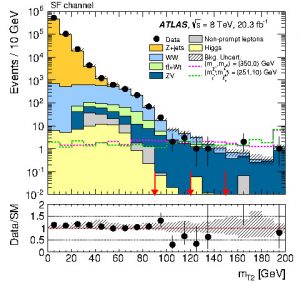
HOW TO READ THE GRAPH
Here represents an analysis of “same flavor” lepton final state involving slepton (Fig.1, top left and bottom right process). The figure on the right shows the distribution of detected events against “transverse mass”, which is a property associated with the missing momentum.
Assuming that the masses of l˜ and ν˜ are 175 GeV, mass of χ˜± is 350 GeV and the mass of χ˜0 is 0, the signal predicted by SUSY (Simplified Model) is shown by the pink dotted line.
As shown by the area graph, the experimental data matches quite well with the Standard Model background signal. The signal from the pink dotted line is not significant, which means that the guess on the SUSY particle mass is probably wrong. Other analyses also failed to give a significant deviation from the Standard Model prediction.
3-leptons final state
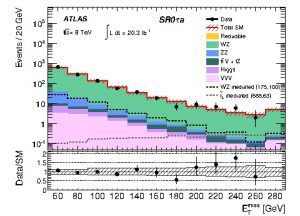
The figure on the right shows the distribution of detected events against ET , the magnitude of missing transverse momentum. The 2 dotted lines show the event distribution contributed by the WZ-mediated and l˜L mediated processes respectively, with Simplified Models.
Again, the observed events are consistent with the Standard Model expectation, within uncertainties.
Conclusion
With the above result, limits are derived on the simplified and pMSSM models. Combining the results, exclusion limits are set on the masses of SUSY particles in various scenarios with simplified models, and improved exclusion limits with pMSSM.
No significant excess beyond Standard Model expectations was observed to support SUSY.
References
- Search for direct production of charginos and neutralinos in events with three leptons and missing transverse momentum in √s = 8TeV pp collisions with the ATLAS detector, arXiv:1402.7029
- Search for direct production of charginos, neutralinos and sleptons in final states with two leptons and missing transverse momentum in pp collisions at √s = 8 TeV with the ATLAS detector, arXiv:1403.5294
